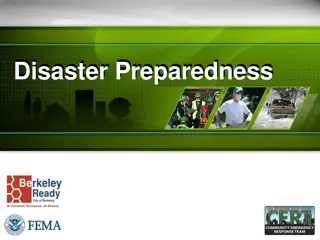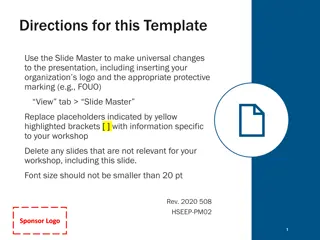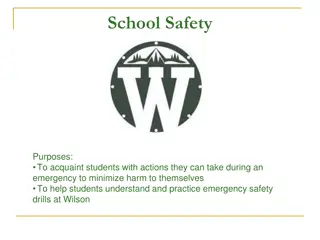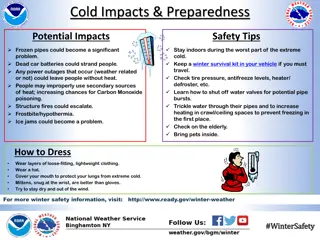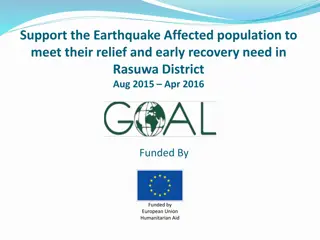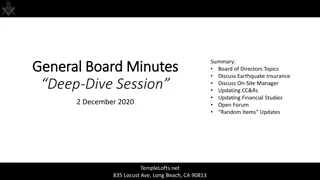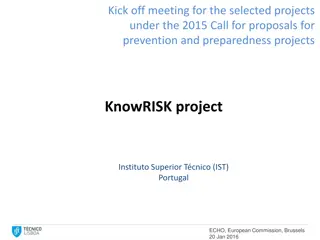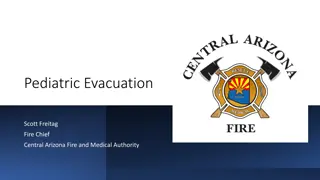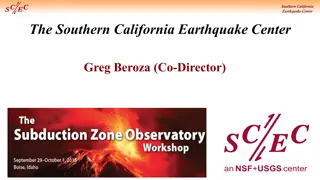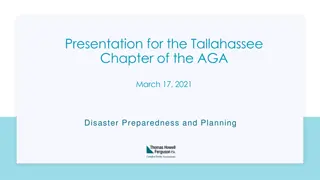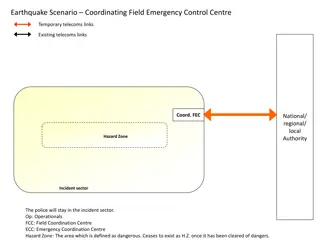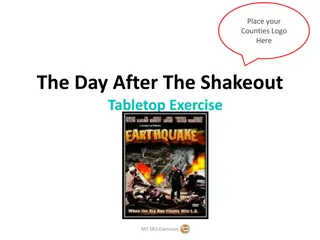Prepare and Stay Safe: A Comprehensive Guide for Earthquake Preparedness
This comprehensive guide covers various aspects of earthquake preparedness, including potential risks, necessary precautions, and steps to take during and after an earthquake. It emphasizes the importance of personal, family, and community preparedness, along with valuable insights on how to reduce risks and improve survival chances. The content discusses overflow effects for other disasters and explores why some people survive while highlighting the vulnerabilities faced by certain groups. It also provides practical advice on how to stay safe in different scenarios and offers valuable resources for further learning.
Uploaded on Sep 14, 2024 | 2 Views
Download Presentation

Please find below an Image/Link to download the presentation.
The content on the website is provided AS IS for your information and personal use only. It may not be sold, licensed, or shared on other websites without obtaining consent from the author.If you encounter any issues during the download, it is possible that the publisher has removed the file from their server.
You are allowed to download the files provided on this website for personal or commercial use, subject to the condition that they are used lawfully. All files are the property of their respective owners.
The content on the website is provided AS IS for your information and personal use only. It may not be sold, licensed, or shared on other websites without obtaining consent from the author.
E N D
Presentation Transcript
Spoiler alert: No ARE YOU READY FOR THE BIG ONE?
More than a shake Liquefaction Landslides Tsunamis
Liquefaction Downtown Seattle
Worst case scenario Compound disaster The New Yorker article (http://www.newyorker .com/magazine/2015/0 7/20/the-really-big- one) Cascadia Rising exercise 2016 Full Rip book
What you should do Duck, Cover, and Hold Take care of yourself first, then family and others
Why and how to prepare Prepare the sequence of levels-individual, family, neighborhood, community Make a plan and set about reducing risk and improving survival chances
This talk Introduction 1 Personal Preparedness 2 Family Preparedness 3 Neighborhood Preparedness 4 Community Preparedness 5 Communications & Situational Awareness 6 Dynamic Preparedness
Overflow effects for other disasters Winter Storms: same except for heating Wildfires: evacuation same Tsunami: evacuation same Tornado: shelter Disease outbreak: slightly different Active shooter: slightly different
Who are the most vulnerable? Elderly Young people Homeless
Psych Chill out Left of boom: depressing, relentless, never safe, money wasted. Right of boom: things will never be the same again; PTSD symptoms
Antidotes Left of boom: Right of boom: Do what you can Step back and pause Use rational tools for decision making Make it a game Talk about it Trust someone Don t allow depression to get rolling Drugs Accept that life is meaningless, or at least, not to be taken too seriously
Some tools Temporal orientation relative to the quake Prioritization of spending Risk mitigation Identify likelihood of location at moment of quake
Pareto Set priorities among a large set of factors See a solution that is good enough Not waste effort
Where are you at Boom? Home 60% Work 15% Commuting 5% Restaurant, Class, Out Vacation or Business Travel
Your Emergency Plan Where are you at Boom? What do you have to do at boom for individual, family, neighborhood, community? What are your risks for each? What is your prioritized purchasing and training plan? What is your testing plan? Are you more ready today than you were a month ago? Quantify it.
Fallacies Dual usage Living off the grid Foraging
1: Personal Preparedness Starts now The first thing right of boom All other preparedness depends on this
The bedside 10 Knife 2 Lights Wallet Passport Cell phone w/charger Medications Glasses Machete Baseball Bat Whistle
Everyday Carry (EDC) Knife Light Cell phone Pen Tools
Good habits Never let the gas tank drop below 75% Never go to sleep without charging your phone Never enter a room or building without considering egress and construction Never fail to replace anything you borrow from your kits before you go to bed Rotate food and water through usage
The bed box Boots Helmet & Lamp Gloves Long Underwear Pants Heavy Socks Rain Jacket Fleece Lights Water Bottle Sign FRS Radios Safety Glasses Nitrile Gloves Neck Cover Gas Shutoff
In the car(s) Go Bag CERT Pack Radios Sleeping Bags & Pads Toilet paper 3 meals, 4 quarts water Warm jacket Maps/Thomas Guide
The Go-Bag 3 changes of clothes and underclothes Tolietries Medications Glasses Electronics and Chargers Boots Athletics shoes Socks 2 Flashlights and batteries Iodine Tablets 4 Energy bars Blanket Important papers Hat The Bag Reading Sunglasses Hand Crank NOAA radio Rain Jacket Fleece Water Bottle Water Filter Moist Towelettes Plastic Trash Bags Dust Mask First Aid Kit Whistle Can Opener Cash LeathermanTool
At work? Where is the point of safety? Do you need to get out of the building after boom? Is there a shelter? Are you on your own or part of a team organized by your employer? Can you go home? Can you see your Emergency Plan on an electronic device? Can you begin to implement, or is getting home your priority?
Training First Aid/CPR CERT Amateur Radio license and ARES courses FEMA courses
What to do individually Denial-Deliberation-Decision Duck, Cover, and Hold Self Assessment-treat injuries Visual check of surrounding area and structure Look for interior lights, exterior lights, glare from fire Listen for human noises, structural noises Find the bedside ten
Individual risks and mitigations Training in medical and CERT nonexistent Pack Go-Bag, EDC, Bedside 10, Bed Box don t have them Figure out what to do at work at boom-no idea Need to practice immediate reaction and thought process-never done that
2: Family Preparedness When-as soon as your individual safety is taken care of, and probably as soon as you are all reunited.
What to do-2 The Picnic (3-5 days) Rally; find your way together, preferably at home. Assess your survival plan and prepare to execute it. Look at weakest links (water? food? money) and mitigate. Care for animals. Test generator and establish electrical power-on periods. Try to establish situational awareness of roads, credit and cash machine, retail stores, damage to infrastructure. Eat leftovers, contents of refrigerator, thawing freezer food. The Campout (2-4 months) Establish routines for eating, drinking, cooking, cleaning, hygiene, defense, and electricity. Start the Map Your Neighborhood response once your family is taken care of. Evaluate the option of leaving.
Rally points and notification plans Assume no phones-establish rally points, one at home, one elsewhere Send a text message of where you are and what your conditions is immediately after the quake Call or text your out-of-area/state contact as a virtual rally Make sure you tell the others what you plan to do
Water 1 gallon/day per person (CDC) 15 liters/day per person (WHO) 4 months/3 people=360 gallons Rationing could reduce this 30% This determines how long the campout lasts, period You have to save bottled water or water in disinfected large containers
Purifying water is all bad choices Activated charcoal filtration: won t get all pathogens Boiling: use fuel; boil for one full minute of roiling Chemical tablets: expensive and taste bad In a pinch, 2 drops of bleach per quart Trying to separate potable from non-potable is not practical A rainwater catchment system for roof downspouts is a good way to get a lot of water in the the Northwest; but only practical if you have enough fuel for constant boiling
Food 2800 calories men 2200 calories women 1400 calories children under 13 50-30-20 Carbohydrates-Protein-Fats Canned Meat-Beans-Fish every day 120 days equals approximately 600-700 cans of food On the picnic, eat leftovers, refrigerated food, frozen food as it thaws; stretch this as long as possible; it doesn t come out of your long term stash Most of us can afford to eat slightly too few calories for two weeks to get the weight loss benefit, so long as the balance and vitamin content are maintained. After that, weigh yourselves once a week to track weight loss and reestablish caloric steady state.
Know the Signs of Malnutrition Listlessness or depression Ketones on breath Skin color change Infections more frequent and heal slowly Difficulty concentrating Difficulty keeping warm
Medical treatment You may have to go beyond your comfort zone: have a couple of advanced outdoor medicine text around Robust first aid kit, including medications the family is currently prescribed Be prepared to suture, clean wounds, deal with compound fractures First Aid/CPR really isn t enough; you need one family member with First Responder training at least
Electrical power Generator Fuel: the weakness; it runs out. You must test your generator once a month most of the year and once a week November through April Use dewatering agent in fuel Cycle fuel through your car every six months Even a built in system with a large gas tank will run out of fuel. Establish a daily schedule to run the house, charge electronics, cook food. Do not run the refrigerator or freezer on generator. If you run the heater, be conservative.
Fuel for heating and cooking Besides heating the house, you must boil water and cook food. You should heat the house before you cook the food. You must calculate your consumption of fuel each day in order to calculate the point of evacuation if you get no resupply. If you are confident of resupply then you should schedule one hot shower day. Make it a Navy shower. If not, cold sponge baths. Your call: comfort vs. survival
Light and Fire Candles-more light leans more fire risk You can t live on batteries You need about four candles per day, or 480 small candles; also five oil lamps, with about 10 gallons of kerosene You need ventilation Fire starter for fireplace, propane stove, lamps. Matches and five other backups
Hygiene Sponge baths Quick daily bathing Wash hands after urinating or defecating-more chance of infection, and no medical treatment available Less water and no vacuuming means more dirt and dust accumulates over time. Also, wood heating spreads more ash and smoke. Requires more frequent mechanical cleaning This begins to be a problem after a week.
Cleaning home spaces and laundry Washing tubs Clothespins Scrub brushes and rags Brooms and mops Tubs for washing dishes and pots
Solid waste Double trash bags Shovels Pre-dig trenches Separate trenches for feces Dry garbage out if possible Deep enough trenches to keep animals out: three feet Farthest extent of property but accessible in rain
Heat Firewood Axe, wedges, saw, sharpener A chainsaw is not for cutting firewood Wood needs to be dried; cutting a cord just after the quake isn t going to do much good Propane refills likely won t be available If you shut off your gas you may not be able to get it back on without the gas company If you have no electricity you probably have no heat unless you have a mechanical valve that bypasses the solenoid and sends gas to a fireplace flame Depending on the type of wood, your discipline, and the weather, you may need two cords of wood
Security: theory of overlapping defenses Nothing can stop determined invaders; multiple layers can stop most of them Layers should overlap Detection and sensors are more important than weapons A large dog is the single best investment in home security you can make (despite the downside of care, food, training, etc.)
Security: layers Sensors: gravel tracks Passive weapons: thorn bushes Passive defense: padlocked gates Passive weapon: dead bolted front, side, rear doors Sensor/Active weapon: working dog Active weapon: machete Active weapon: baseball bat Active weapon: knife
Security: no one wants to talk about this Guns require licenses, training, ammunition, regular cleaning, target practice, safe and secure storage. All of this is the minimum. Ideal mix is one 12 gauge shotgun, one M4 assault rifle, one .45 ACP pistol, and one 9mm automatic pistol. This is the ideal combination of long, medium, and close-in ranges and rates-of-fire. Invaders don t necessarily know you have guns, so deterence is limited. In the extremely unlikely event that you need a gun, you will be glad you have one (or four)


